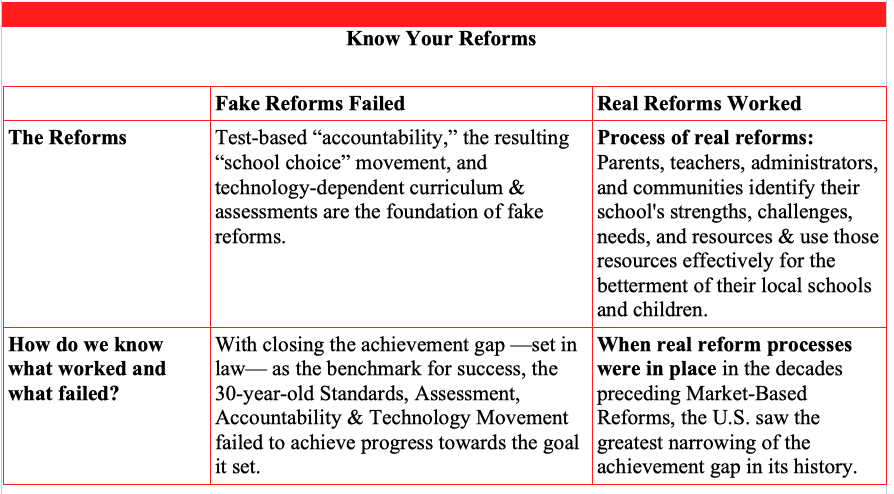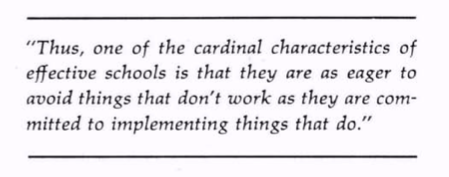Real reforms in education have to take place at the classroom level — where the students are. Because that is true, the reform process requires seeing the local school as the center-point for real reforms.
Fake reforms focused on outcomes from commercially-developed standardized tests. In essence, this practice took what was a periodic monitoring tool —known to be nothing more than a limited snapshot— and used it yearly to produce results for marketing purposes.
The marketing of reforms has been exceptional. But the truth remains — fake reforms have not made public education in America better. Yet, progress continues to be made because many caring individuals continue to do the right things for students.
A better way forward would be to quit funding what is failing to work and fund what does.
 How do we know what’s true and what’s false? EVIDENCE !
How do we know what’s true and what’s false? EVIDENCE !
Has the Standards, Assessment, Accountability & Technology Movement really been pushing Market Based Reforms for 30 years? Yes, 30 years plus.
“ … moving into a knowledge-based economy … we can’t expect the smokestack industries to create the new employment. …”
“Then we have to ask, ‘What is industry in a knowledge-based economy?’ The answer is the education industry. … So, if our economy is going to be competitive, the education industry has got to be competitive.”
Children’s education was never the primary purpose for Market Based Reforms.
“ … the key to engaging a long-term interest and commitment of companies is the adoption of a reform strategy …”
Mr. Lewis Branscomb ( IBM chief scientist, Chair of the Task Force on Teaching for the Carnegie Foundation) National Governors Association Annual Meeting Proceedings, 1986 (pg. 30-31)

What about the claim that progress in narrowing the achievement gap was being made before the adoption of Market Based Reforms? It’s true.
“From the early 1970s until the late 1980s, a very large narrowing of the gap occurred in both reading and mathematics, with the size of the reduction depending on the subject and age group examined.”
The Black-White Achievement Gap When Progress Stopped. Policy Information Report (pg. 6) © 2010 Educational Testing Service
The paper linked above examined multiple societal forces impacting National Assessment of Educational Progress (NAEP) gap reduction and why that progress halted. But missing was any discussion of the ORIGINAL Effective Schools Research. Without those original observations and conclusions —about high-minority, high-poverty, high-“achieving” schools— the discussion of what reforms work is incomplete.

So, according to research, what worked for Effective Schools?
First, it’s important to note the time-frame of the research. In 1974 Ronald Edmonds’ research team set-out to answer this question: “Are there schools that are instructionally effective for poor children?” The answer was yes! And Edmonds continued that research until his untimely death in 1983 at the age of 48. His original Effective Schools Research occurred smack in the middle of the swiftest narrowing of the achievement gap in our history.
What did they find?
By 1979, it was clear to Edmonds that several other research groups were confirming some of his findings and it appeared that “no one model explains school effectiveness for the poor or any other social class subset.” But regardless of their differences, by 1982 Edmonds had narrowed his findings to five common characteristics in these high-performing schools. More importantly, he noted the commonalities of their school improvement programs. Their process of improvement focused on better use of existing resources, accepting all children as capable, and understanding that measurements of progress for analysis and intervention had to be based on the local school’s goals.
Real school reforms work when everyone involved in and with the school is committed to establishing a culture in which every student is expected to learn to the limit of their ability and grow as a human being.
Please help make every school an effective school. Share what works.
And learn more about how to better identify fake reform groups so we quit wasting precious time and money on buying into the same reforms with new names, which continue to fail to improve schools.
